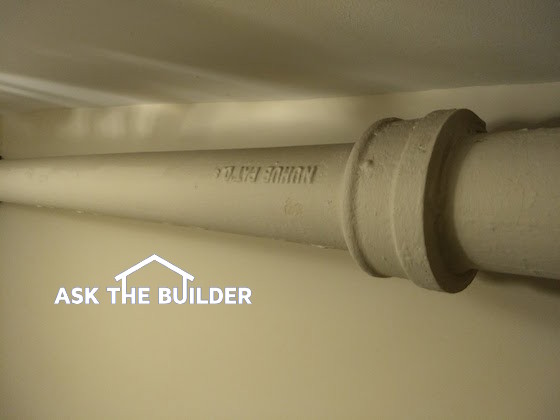Cast Iron Plumbing Pipe – It’s Quiet!

Here's a typical cast iron drain pipe. It's suspended from the ceiling in a stairwell in one of the oldest buildings in Southwest Harbor, Maine. You can see how the lettering is cast into the pipe. Copyright 2018 Tim Carter
DEAR TIM: I recently was visiting with some friends. While sitting in their family room, I heard water rush down the wall next to me. It was very objectionable. Evidently, someone had just finished using the toilet facilities in an upstairs bathroom. I don't have that problem in my older home and I'm afraid it might develop over time. What caused the noise? Is the problem avoidable? W. D.
DEAR W. D.: Based upon your description, your friends' plumbing drainage system is constructed of either PVC or ABS plastic piping. This piping material was introduced in the early 1970's. These products were sold on the basis that they were cheaper and easier to install than cast iron and galvanized piping. However, plastic piping materials have two major drawbacks: they are very noisy and they expand and contract readily.
You do not have the problem in your home because your drainage piping is constructed of cast iron. Cast iron plumbing pipes are very durable and quiet. Cast iron piping installed 372 years ago in France is still in service. The same is true for cast iron installed in the White House during the 1800's. Rest assured that the noise problem will not develop in your present home.
Cast iron piping manufactured today is very different from the cast iron piping made at the turn of the century. Cast iron pipe, years ago, used to be static, or sand cast. This method allowed for wide variances in pipe wall thickness. Also, the sand casting methods often produced tiny pinhole leaks. The old pipes were connected by inserting the spigot end of one pipe into the hub end of another pipe. This joint was then partially packed with oakum (hemp impregnated with tar). Molten lead was then poured into the joints to complete the seal. The process was very labor intensive.
New cast iron pipe is cast using a centrifugal spinning process. This process assures consistent pipe wall thicknesses. Many manufacturers water test their pipe to check for leaks. Cast iron fittings are still static cast, however, modern casting methods assure high quality pieces. The cast iron pipes and fittings of today are joined with rubber and stainless steel clamps. Believe it or not, cast iron piping can be installed faster than plastic piping.
Cast iron plumbing is very quiet. This results from its dense molecular structure and the use of rubber between sections of pipe and fittings. The rubber gaskets and seals isolate the pipes and fittings and help to absorb sound vibrations. The sounds you heard at your friends' house were created by the vibrations of the water bouncing against the sides of the lightweight plastic piping. Plastic piping can also create popping noises when hot water passes through it. The plastic pipes expand and often rub against the wood framing members inside of walls. Cast iron piping will rarely, if ever, cause this problem.
Should you decide to build or remodel, cast iron piping is also very affordable. In fact, it only costs on average, $150 per bathroom to upgrade to cast iron pipe. You can minimize this extra cost by using both cast iron and plastic piping in your home. Use cast iron for all of the drainage pipes that handle water wastes and use plastic piping for all of the fixture vent pipes.
Cast iron is also environmentally friendly. It is made from 100 percent recycled scrap iron and steel. Should your home be demolished in the future, you can recycle cast iron. Plastic piping, on the other hand, can not make these claims. The solvents which are used to weld the pipes together are highly toxic. They produce fumes which dissipate into the atmosphere. In order to avoid becoming sick while using these solvents, adequate ventilation becomes a necessity. Plastic piping is not easily recycled. Often it ends up devouring space in our dwindling landfills.